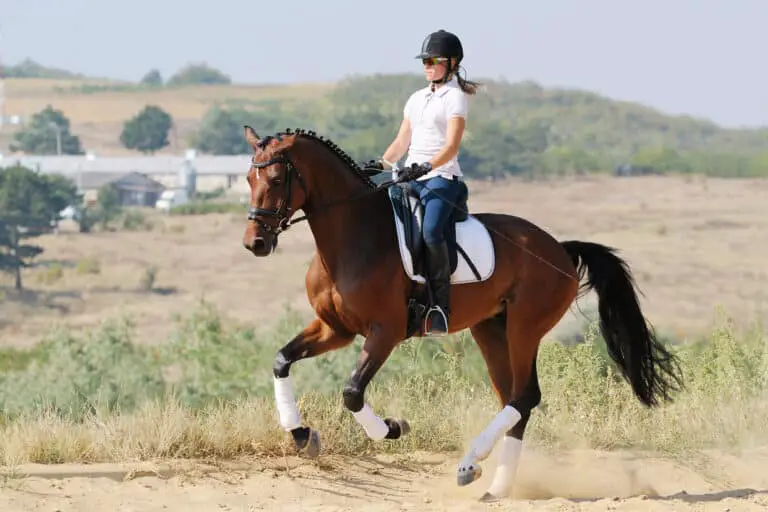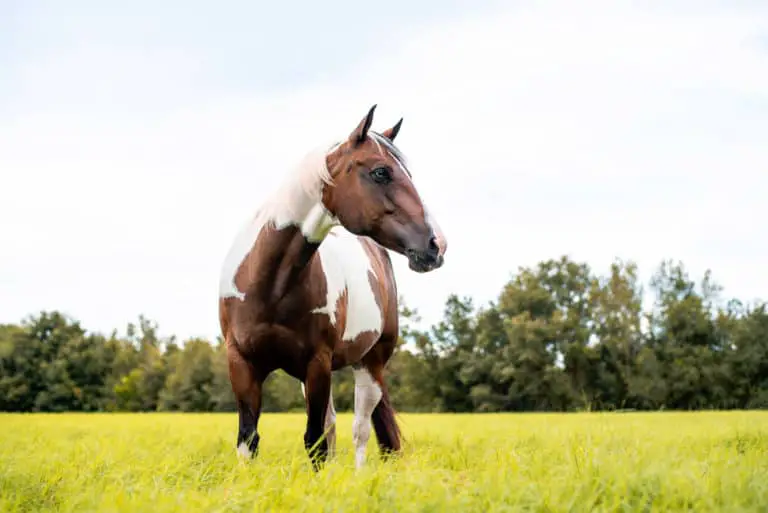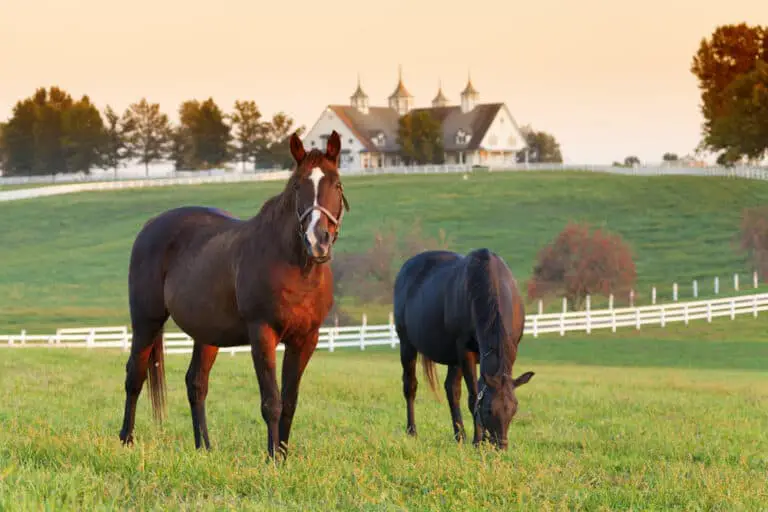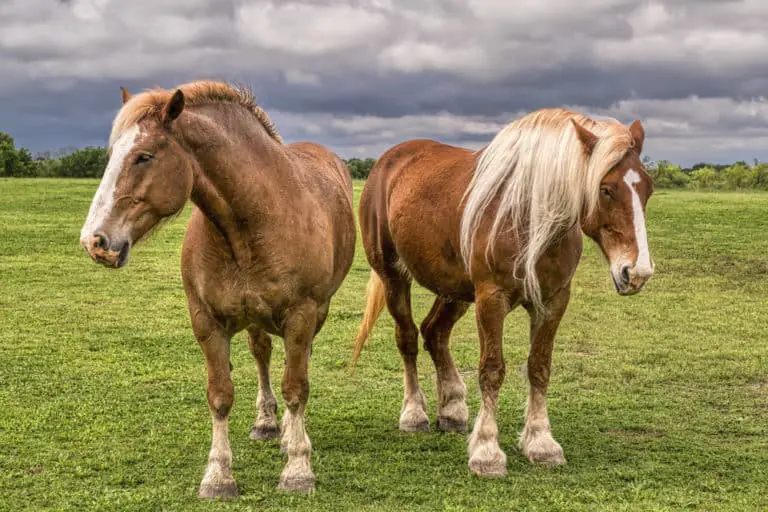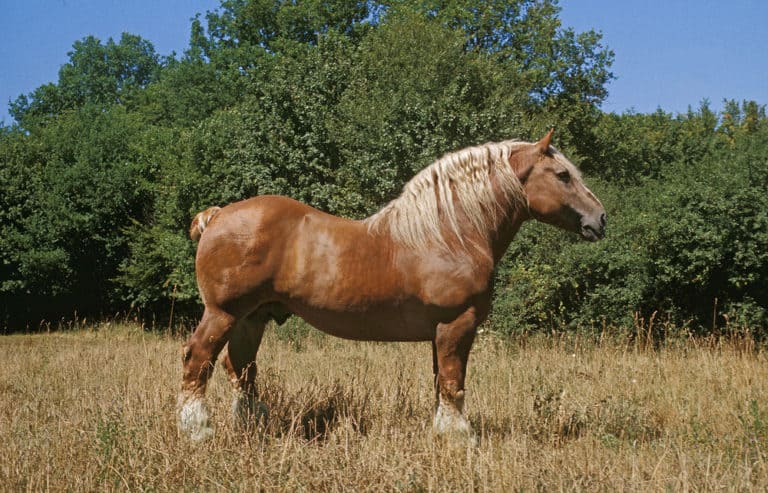Thoroughbred Horse: Care, Cost & History (2025)
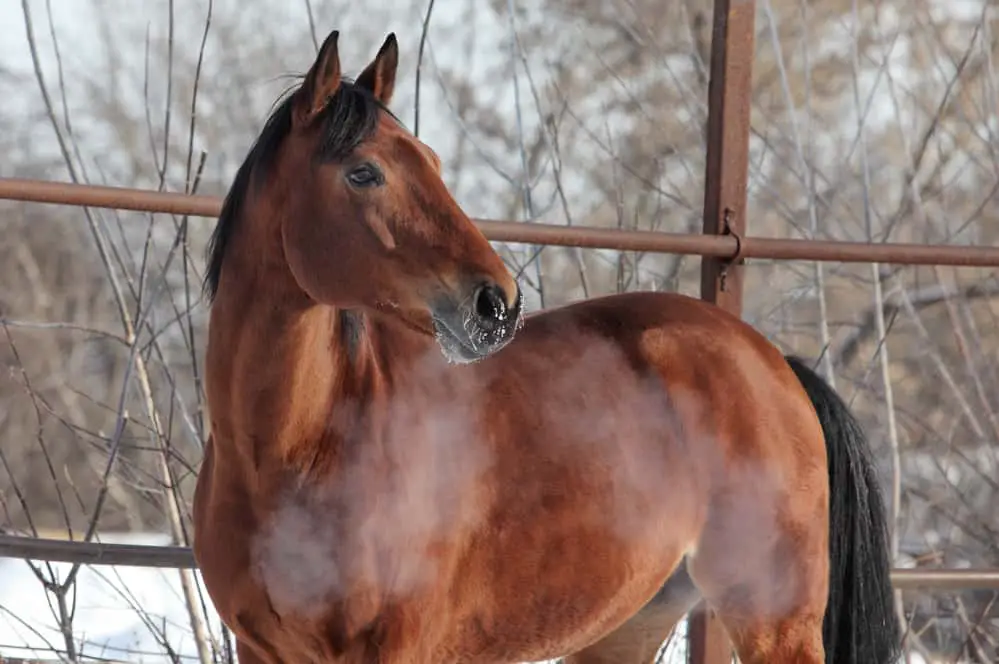
Horse racing is the sport of kings and the Thoroughbred horse is the reason the sport exists. The breed was developed by royalty – including kings – in England and racing was a way they tested their horses and enjoyed themselves. While they are known for their speed, the Thoroughbred is enjoyed by equestrians throughout the world.
Breed: Thoroughbred horse
Adult Weight: 1,000 pounds
Adult Height: 15-17 hands (60-68 inches)
Origin: England
Use: Racing, Dressage, Jumping, Polo
Colors: Bay, black, grey, brown, and chestnut
Features: Delicate head, short back, long legs
Lifespan: 25-28 years
Character: Intelligent, people-oriented, sensitive, can be nervous
Gait: Spirited and forward moving, long smooth strides
Best for: Intermediate and experienced riders
- Characteristics
- Thoroughbred Care
- Thoroughbred History
- Modern Thoroughbreds
- Cost and Ownership
- Buying a Thoroughbred
- Similar Breeds
Thoroughbred Horse Characteristics
The Thoroughbred horse head is delicate with large, intelligent eyes and nostrils. They have a regal appearance, with long, clean lines that smoothly connect their wide chest to short back and hindquarters.
An athletic body is one of the key Thoroughbred horse characteristics. Although their legs are long, the individual bones are short, allowing for a longer stride.
Size
The Jockey Club is the breed registry in the United States and says that the average height is 16.1 hands. (1) Thoroughbred horse height can range from 15 to 17 hands, and females are slightly smaller than males. (1)
This is tall among horse breeds, at least those used for riding. Thoroughbred size is influenced by their long legs. Non-adult horses have grown to 84% of their adult height when they are six months old. (2)
There is a myth that racing horses when they are two and three years old damages them and causes a greater risk of injury, but scientific research shows this is unfounded given how quickly they mature to full-size. (3)
Weight
Thoroughbred horse weight averages 1,000 pounds, according to The Jockey Club. (1) Again, stallions and geldings weigh slightly more than mares. A Thoroughbred foal, or non-adult horse, is at 46% of their mature weight when they are six months old. (2)
However, they reach their final mature weight at a slower rate of gain than they reach their final size in height. Thoroughbred horses reach their final weight after they turn two years old; they are only at 90% of mature weight at 22 months. (2)
The bone structure of Thoroughbreds and the bone development process isn’t complete until the horse is six-years-old; steady, continuous bone growth is shown to be healthiest. (2)
Colors
Bay, black, grey, brown, and chestnut are the common Thoroughbred horse colors. (4) Years of careful breeding have made these predominant.
Rare Thoroughbred horse colors include roan, palomino, and white, which is recognized as a distinct color from grey. (4)
White markings on the face and legs are common on the beautiful Thoroughbred horse and are sometimes referred to as chrome.
For example, the racehorse California Chrome, who won the 2014 Kentucky Derby and Preakness Stakes, has a white blaze on his face and four white socks on his legs.
He received his name because of his white markings and his fans are called “Chromies.” (5)
Temperament
Thoroughbred horse temperament has a reputation for being sensitive and high-strung. This broad generalization doesn’t paint the full picture though.
The Thoroughbred breed has high energy and is competitive – this makes sense, they were bred to race. They are also intelligent, with a strong work ethic, are kind, and people pleasers. (6) Each horse has a unique temperament, the same way people do.
Their care and upbringing influence Thoroughbred horse behavior. Their temperament means they are not ideal for inexperienced riders, but they are wonderful horses for experienced people.
Thoroughbreds don’t have breed rules with the United States Equestrian Federation and use the general rules that state children cannot exhibit stallions. (7)
Thoroughbred Horse Care
Since the Thoroughbred horse breed is a high-energy breed, exercise is important.
Their sensitivity also means they can be harder to care for, but if the horse’s mental and physical needs are met, they are easier to care for.
Thoroughbred horse lifespan is 25 to 28 years; well-cared-for horses remain usable throughout their lives.
Diet and Nutrition
All horses need water, fats, carbohydrates, minerals, vitamins, and protein to survive. (8) Horses consume about two percent of their body weight in feed every day. (8)
The foundation of the Thoroughbred diet is roughage or forage – the hay and grass the horse eats. This should be the largest part of their diet; grain, protein, and fat supplements are added in to balance their diet, for growth, and performance.
Finally, access to clean, fresh water is essential at all times. The diet and nutrition needs of Thoroughbred racehorses are different from growing horses, those in lighter work, and senior horses.
An equine nutritionist can help determine the horses’ nutritional requirements. (8)
Health Problems
Thoroughbred horses have some health problems. Gastric ulcers are a problem in all horses, especially in racehorses. These can be prevented through adequate forage in the diet, lifestyle changes, and treatments. (9)
Research shows that American Thoroughbreds are susceptible to respiratory diseases, including exercise-induced pulmonary hemorrhage, and the neuromuscular problem called tying-up that is also exercise-induced. (10)
Working with a trainer and veterinarian can prevent some of these issues from developing.
Genetic problems in Thoroughbreds include parrot mouth, where the top of the mouth and teeth is further forward than the bottom, and in rare cases, contracted foal syndrome, where the leg joints don’t form correctly. (11)
Grooming
Basic horse grooming principles apply across all breeds; although a racehorse breed also has individualized requirements. Grooming is done daily to check for injuries, skin issues, and overall well-being.
Thoroughbreds have sensitive skin and can be more susceptible to insect bites or other issues. (12) Cleaning the hooves daily is imperative and helps ensure the horse stays sound. (12)
Thoroughbred grooming includes caring for the mane and tail, cleaning the face with a soft brush or towel, and using a curry comb and brushes on the body. (12)
The legs are sensitive and only brushes are used on them; grooming also provides an opportunity to check tendons and ligaments for swelling. (12)
Thoroughbred Horse History
Three stallions – the Darley Arabian, Godolphin Arabian, and Byerly Turk – were brought to England from the Mediterranean Middle East and created the foundation of Thoroughbred horse history.
The stallions became the founders of the breed. Their thrilling history continued as the breed expanded throughout the world and captivated the dreams of many.
Origin
Native horses in England lacked the pizazz that the three founding sires had. The cross between these Arabian stallions and the mares in England in the 1600s and 1700s created a tall, strong horse, able to sustain its speed over distance.
Although the breed originated with the aristocracy of England, it expanded worldwide as others wanted similar horses. Thoroughbred horse origin is unique compared to other breeds because it’s so well documented.
Meticulous records trace the genealogy of horses for generations. The Arabian breed and the native mares of England are the ancestors of the Thoroughbred, however, all modern horses trace their lineage back to the three foundation sires.
Historic Development
The breed was originally developed in England over 300 years ago. Careful breeding of horses resulted in consistent breed characteristics after a few generations.
The race track was used for both sport and to prove the superiority of horses. Bloodlines were the protected knowledge of families until the studbook was established in the 1790s.
Earlier in the 1700s, others began exporting horses and establishing the breed in their own country.
The American Thoroughbred horse started with the first import in 1730 and grew from there as more horses were imported. Today, there are more Thoroughbreds in the United States than anywhere else.
Notable Thoroughbred Horses
The registries throughout the world are filled with famous Thoroughbred horses. They include racehorses, Olympic athletes, or movie stars. Some are famous because of the scandals.
Shergar, an Irish racehorse with an elite Thoroughbred horse pedigree, was stolen in 1983 and held at ransom for two million pounds, before injuring his leg and being euthanized.
Bulle Rock
Bulle Rock was the first Thoroughbred horse imported from England to the United States. He arrived in 1730; Samuel Gist of Virginia imported him.
Bulle Rock was a son of Darley Arabian and had raced successfully in England. He was used for breeding in the United States and was the first of many imports. (1)
Secretariat
Secretariat was a chestnut Thoroughbred stallion with the nickname Big Red that won the Triple Crown in 1973, including the Belmont Stakes by a whopping 31 lengths.
He still holds some track records, and is known as a broodmare sire, and is the grandsire of Storm Cat and A.P. Indy, among others. (13)
American Pharoah
Affirmed won the Triple Crown in 1978; other horses came close but couldn’t win. People wondered if it was too hard. Then, along came American Pharoah in 2015.
He reinvigorated the sport and brought a jubilant crowd back to the grandstands. The Triple Crown champion is standing as a stallion at Coolmore Farm. (14)
Myths and Legends
Many Thoroughbred horse legends center around racehorses and their amazing feats on the track, whether a flat track or steeplechase.
There are unmatched athletic feats seen with horses like Man o’War and Secretariat, and legends about what really happened to horses. Finally, there are legends related to tracks and locations, although not all are positive.
Man o’War – The GOAT
Man o’War is the greatest of all time (GOAT) for racehorses. His 28-foot stride is still a record. The Belmont family bred him in Kentucky – the same ones the race and track are named after.
He was the original Big Red and had the look of eagles, often standing gazing off into the distance.
The Death of Shergar
It’s been almost 40 years since Shergar disappeared, and his captors and demise still remain a mystery. He was only five years old when he was kidnapped, and worth $15 million.
Eight men stole him at gunpoint from his stable, it’s said that they were part of the Irish Republican Army (IRA) and trying to raise money for guns.
Saratoga: The Graveyard of Champions
The Saratoga Racetrack has rightly earned the nickname the Graveyard of Champions as it has seen more noteworthy upsets than any other track.
Man o’War (1919), Gallant Fox (1930), Secretariat (1973), and American Pharoah (2015) all suffered defeats at Saratoga. The clincher is that Man o’War lost to a horse named Upset.
Modern Thoroughbred Horses
Horses like Triple Crown winners American Pharoah and Justify keep Thoroughbreds popular.
The racing horse breed also has programs like the Thoroughbred Incentive Program that connect horses to new careers after the track.
Although there are different types of Thoroughbred horses, the majority are still bred to run for the roses.
Breeding
Thoroughbred horses breeding happens throughout the world, with the largest population in the United States. Although the breed is large in terms of the number of horses, inbreeding is an issue and there isn’t much genetic diversity. (15)
The Jockey Club still only allows live cover, further limiting genetics. Thoroughbreds are used for racing, hunters, jumpers, dressage, and eventing.
But, the most successful Thoroughbred breeding in each of these disciplines is the same – just in a different order.
Nasrullah tops the list in all sports disciplines, followed by Man o’War, Princequillo, Native Dancer, and Precipitation. This shows consistency within the breed, but can also limit the long-term health of the breed. (16)
Population
Globally, there are around 500,000 in the Thoroughbred horse population, and about half of these are in the United States. (15) There was a population surge in the 1980s, but this peaked and the current breeding rate is more sustainable.
Many horses move out of the racehorse population and are used in other disciplines, further helping the population grow. Finding ex-racehorses a job and a new home is crucial for keeping the population stabilized.
For example, Blackfoot Mystery is a Thoroughbred horse gelding that raced three times and is now a three-day eventing horse for Boyd Martin, even competing in the 2016 Olympics. (6)
Uses
Thoroughbred horse uses are diverse, it started with racing and that tradition continues today. They are also popular horses in polo, dressage, jumping, fox hunting, and other disciplines.
The first horse race in the United States was in Annapolis, Maryland in 1745, and today’s Thoroughbreds are still bred to run. This makes them adaptable to other sports disciplines where athleticism is a prerequisite, including three-day-eventing and dressage.
Furthermore, the Thoroughbred horse gait is smooth and fluid, using their strength to eat the ground in front of them as they work. Although most popular in these divisions, they can be found in almost any type of equestrian pursuit.
Thoroughbred Horse Prices
Thoroughbred horse price depends on whether you are buying a racehorse prospect, a second career racehorse, or one bred for another sport such as eventing.
Purchase prices are influenced by bloodlines, and while this is the preliminary expense, ongoing care of the horse – board, feed, and veterinary expenses – adds to the cost each year.
Purchase Price
The price of a Thoroughbred horse is determined by its age, breeding, intended use, and amount of training. Racehorses are the most expensive.
The Jockey Club lists the average and median prices for yearlings; in 2020 the average was $62,208 and the median was $18,000. (17)
Thoroughbred horse bloodlines that are proven winners increase the price. An Off The Track Thoroughbred (OTTB) is another option.
These horses are seeking a second career after racing, or because they are not competitive. Whether or not the horse was retrained for saddle work can influence the price; the average cost is $2,894 for an OTTB. (18)
Ownership Costs
The Thoroughbred horse cost of ownership is significant for a racehorse, but even a horse used for jumping, dressage, or another discipline has an expensive annual upkeep cost.
A non-racehorse will cost between $1,770 and $12,930 every year. This is in addition to the Thoroughbred price for buying the horse. (19)
Board
Board is the horse’s home. It consists of a barn or shelter and some sort of pasture or turnout. Thoroughbred horse board cost is $1,200 to $7,200 each year, depending on the location, and are paid monthly. This does not include training, only the facility where the horse lives. (19)
Feed
Next, the horse needs to eat every day. Forage, or hay and grass, comprises most of the daily diet. Grain and supplements are also part of their diet. Thoroughbreds are high energy and as such need more feed than other breeds. Expect to pay between $250 and $4,380 per year for Thoroughbred horse feed cost. (19)
Vet Care
Vet care is an essential part of horse ownership and includes vaccinations, deworming, and dental care. It must be completed annually and helps ensure horses are happy and live a longer life. The Thoroughbred horse veterinary cost is $200 to $350 each year, but add on $500 to $1,000 extra for any sickness or injuries that may occur. (19)
Hoof Care
The saying is no hoof, no horse. It’s a true statement, and horses need hoof care every six to eight weeks by a trained farrier. Thoroughbred horse hoof care cost is $120 to $1,000 annually. Some Thoroughbreds require shoes, and this means they will cost closer to $1,000 each year. (19)
Buying a Thoroughbred Horse
Buying a horse means doing homework. There are a lot of options in the Thoroughbred breed – horses off the track or bred for other disciplines.
Select criteria and then look at lots of horses. Even if you end up buying the first one, you’ll be more confident in your purchase knowing you looked at others before deciding.
Is the Thoroughbred Horse Right for You?
The first thing to consider about owning a Thoroughbred horse is if you will consider one that has raced or not. There are many excellent horses looking for a second career after the track, but you must be an experienced rider.
Thoroughbred training is imperative; horses receive different training to race than in other disciplines. Once the horse has been properly retrained, riding a Thoroughbred horse is a blast.
You truly feel like you are flying, Thoroughbreds have speed and power, and a huge heart – they want to make their riders happy. Speed and power are also why Thoroughbreds need experienced riders, to channel the energy and keep both the horse and yourself safe.
How to Buy a Thoroughbred Horse?
The first thing to do is identify a Thoroughbred breeder who can help navigate the organizations with OTTB horses, breeders with horses, or the sales that occur.
Look at numerous horses before buying a Thoroughbred horse and invest in a veterinary inspection. Avoid situations where the seller tries to rush you into purchasing the horse.
Similar Breeds to Thoroughbred
There are Thoroughbred horse alternatives. The breed originated from Arabians and the Barb horse. It has also been used to create, strengthen and improve other horse breeds, including the Quarter Horse and Standardbred.
The Arabian has the heart and endurance of the Thoroughbred, while the Barb has the same physique and Standardbreds have the speed.
Arabian
The Arabian originated on the Arabian Peninsula in the Middle East and their bloodlines are found in many other breeds, including the Thoroughbred. Arabians provided Thoroughbreds with heart, spirit, and endurance, as well as adding a beautiful head. They are a popular breed throughout the world, including in the United States where they are popular for endurance.
Barb
The physique of a Barb horse is similar to a Thoroughbred, but this hardy North African horse is a distinct breed. They are fast, strong, and easy to tame. Riders frequently go bridleless to prove the level of connection and training their horse has. The Barb horse population is not large, but their riders are devoted to them.
Standardbred
The Standardbred breed traces its origin to Messenger, a Thoroughbred stallion foaled in England, and they have similar breed characteristics. They are America’s harness racing horses and are known for trotting and pacing. Standardbreds are just a bit slower than Thoroughbreds, with their top speed between 30 and 35 miles per hour.
FAQ
What is a Thoroughbred horse?
Thoroughbreds are a horse breed popular in racing and other athletic disciplines. They developed in the 17th and 18th centuries through careful breeding.
What does a Thoroughbred horse look like?
Thoroughbred horses are tall with a delicate head, wide chest, short back, and long legs. They are predominantly bay, brown, chestnut, black, and grey.
How did the Thoroughbred horse get its name?
The Thoroughbred horse name developed in England alongside the breed and means a purebred or well-bred horse with a known pedigree.
Can you ride a Thoroughbred horse?
Yes, Thoroughbreds were bred to ride, and are popular in many disciplines from jumping to racing.
Are Thoroughbred horses good for beginners?
Thoroughbreds are spirited and forward movers. This means they are not good for beginners. Some horses that have not raced are ridden by beginners.
How tall is a Thoroughbred horse?
The height range for a Thoroughbred horse is 15 to 17 hands (60 to 68 inches). The average height is 16.1 hands (65 inches).
How much does a Thoroughbred horse weigh?
The average weight for a Thoroughbred horse is 1,000 pounds.
How big is a Thoroughbred horse?
Thoroughbred horses are considered an average height and weight, with most around 16.1 hands and 1,000 pounds.
How much does a Thoroughbred horse cost?
The average price for a Thoroughbred yearling in 2020 was $62,208 and the median price was $18,000.
How much does Thoroughbred horse ownership cost?
Thoroughbred horse ownership costs between $1,770 and $12,930 each year.
How long do Thoroughbred horses live?
Thoroughbred horses live for 25 to 28 years.
How fast can a Thoroughbred horse run?
The average speed for a Thoroughbred horse is 40 miles per hour.
How much can a Thoroughbred horse pull?
Thoroughbred horses can pull 1,500 pounds.
How much can a Thoroughbred horse carry?
Thoroughbred horses can carry 200 pounds.
At what age is a Thoroughbred horse full grown?
Thoroughbreds grow fast, otherwise, they would not be racing as two-year-olds. They are full-grown by four or five years old at the latest.
What are Thoroughbred horses used for?
Thoroughbred horses are used for a variety of disciplines including racing, dressage, jumping, fox hunting, polo, and others.
References
- The Jockey Club. 2006. Thoroughly Thoroughbred. Link
- Kentucky Equine Research. 2018. Principles of Bone Development in Horses. Link
- Alyssa A. Logan, Brian D. Nielsen. 2021. Training Young Horses: The Science behind the Benefits. Link
- International Museum of The Horse. 2022. Thoroughbred. Link
- America’s Best Racing. 2022. California Chrome. Link
- Thoroughbred Aftercare Alliance. 2022. Link
- United States Equestrian Federation. 2022. Licensed Competitions. Link
- Carey A. Williams, Ph.D., Rutgers New Jersey Agricultural Experiment Station. 2004. The Basics of Equine Nutrition. Link
- Nidirect Government Services. 2022. Protect horses from pain, suffering, injury, disease. Link
- K. W. Hinchcliff, L. L. Couetil, P. K. Knight, P. S. Morley, N. E. Robinson, C. R. Sweeney, E. van Erck. 2015. Exercise-Induced Pulmonary Hemorrhage in Horses: American College of Veterinary Internal Medicine Consensus Statement. Link
- University of Kentucky College of Agriculture, Food, and Environment. 2013. Equine Genetic Disorders Reviewed. Link
- United States Equestrian Federation. 2022. Basic Horse Grooming. Link
- ESPN. 2022. Secretariat remains No. 1 name in racing. Link
- Belmont Stakes. 2015. American Pharoah. Link
- Beatrice A. McGivney, Haige Han, Leanne R. Corduff, Lisa M. Katz, Teruaki Tozaki, David E. MacHugh & Emmeline W. Hill. 2020. Genomic inbreeding trends, influential sire lines and selection in the global Thoroughbred horse population. Link
- Sporthorse Data. 2022. Thoroughbred Bloodlines Successful in the USA. Link
- The Jockey Club. 2022. Average/Median Price Per Yearling. Link
- Retired Racehorse Project. 2014. OTTBs By the Numbers. Link
- Arabian Horse Association. 2022. What is the Cost of Providing for Them? Link

